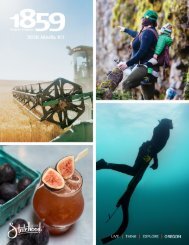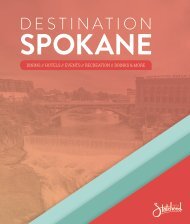1859 March | April 2018
You also want an ePaper? Increase the reach of your titles
YUMPU automatically turns print PDFs into web optimized ePapers that Google loves.
what i’m working on<br />
Saving the Shellfish<br />
Alan Barton uses science to solve a mystery<br />
interview by Gina Williams<br />
IN 2007 AND 2008, baby oysters began dying at Pacific Northwest<br />
shellfish hatcheries that rely heavily on aquacultured seed stock.<br />
The cause remained a mystery, until one morning when Whiskey<br />
Creek Shellfish Hatchery production manager Alan Barton walked in<br />
and everything was dead.<br />
Barton realized the problem might be from the water in Tillamook’s<br />
Netarts Bay where Whiskey Creek, Oregon’s only shellfish hatchery<br />
and the second largest shellfish hatchery on the West Coast,<br />
is located. It turned out the mass die-off coincided with a large<br />
upwelling event along the Oregon Coast that brought corrosive<br />
seawater with a low pH into Netarts Bay. Barton turned to his former<br />
colleagues at Oregon State University’s oyster-breeding program for<br />
help. Fortunately, Burk Hales, an OSU professor of ocean ecology<br />
and biogeochemistry, confirmed acidification was the culprit and<br />
developed a way to measure the chemistry of the Netarts Bay<br />
water. The hatchery also began working with the National Oceanic<br />
and Atmospheric Administration (NOAA) in 2010, and today the<br />
hatchery is back to nearly full production. Barton and researchers<br />
caution the current fix might not work forever.<br />
Whiskey Creek Shellfish Hatchery production manager Alan Barton<br />
helped determine the cause of a massive shellfish die-off a decade ago.<br />
What has near disaster at Whiskey<br />
Creek taught us about ocean<br />
acidification and climate change?<br />
Burning fossil fuels has increased<br />
the concentration of CO 2<br />
(carbon<br />
dioxide) in the atmosphere by about<br />
30 percent, which has increased the<br />
acidity (decreased pH) of the ocean<br />
by about 30 percent. For young<br />
shellfish at their most vulnerable<br />
state, especially in their first two<br />
weeks of life, a low pH environment<br />
causes shell deformation and<br />
often death.<br />
Research shows that unless we<br />
decrease ocean CO 2<br />
by moving<br />
toward less fossil fuel emissions,<br />
extreme events will only get worse<br />
over time.<br />
It’s important to note that ocean<br />
acidification and global warming are<br />
not the same thing. They are different<br />
impacts of increasing concentrations<br />
of CO 2<br />
. Acidification is much more<br />
straightforward and indisputable.<br />
What are you doing to manage the<br />
situation today?<br />
We are now constantly monitoring<br />
pH levels in Netarts Bay. We’ve also<br />
learned to pump water in the afternoon<br />
when acid levels tend to measure<br />
lower. Professor Hales created a way<br />
to measure the chemistry of the water<br />
used for spawning. The effort also<br />
resulted in a self-contained monitoring<br />
system that continuously collects<br />
research-quality water chemistry data,<br />
but can be operated in-house. We’ve<br />
also learned how to buffer our water<br />
with sodium carbonate to keep the<br />
shellfish seed healthy.<br />
What’s next?<br />
In 2011, the NOAA Ocean Acidification<br />
Program (OAP) was started with<br />
bipartisan support after the shellfish<br />
industry and community leaders<br />
urged funding for ocean acidification<br />
research. Congress subsequently<br />
increased investment to NOAA<br />
OAP. Research and collaboration with<br />
scientists has allowed us to expand<br />
monitoring across the West Coast and<br />
create a type of ocean acidification early<br />
warning system that benefits the entire<br />
shellfish and aquaculture industry—an<br />
industry worth about $270 million a<br />
year of economic activity and employs<br />
about 3,200 people in rural communities<br />
throughout the region. Researchers are<br />
also now developing ocean chemistry<br />
forecasts to help hatcheries time<br />
activities to maximize output.<br />
In addition, Professor Hales’ research<br />
has resulted in deployment of monitoring<br />
systems in shellfish facilities and marine<br />
laboratories from California to Alaska.<br />
And in February <strong>2018</strong>, the Ocean<br />
Carbon and Biogeochemistry Program,<br />
a project of the interagency U.S. Carbon<br />
Cycle Science Program, is hosting the<br />
fourth U.S. Ocean Acidification Principal<br />
Investigators meeting in conjunction<br />
with the <strong>2018</strong> Ocean Sciences Meeting<br />
in Portland.<br />
68 <strong>1859</strong> OREGON’S MAGAZINE MARCH | APRIL <strong>2018</strong>

















